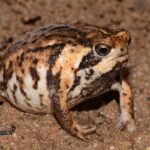- Ischnocnema nanahallux: Discovering the Secret World of a Lesser-Known Frog Species
- Taxonomy and Classification
- Natural Habitat: Hidden Treasures of the Brazilian Atlantic Rainforest
- Physical Characteristics: Camouflaged Wonders of Evolutionary Ingenuity
- Behavior and Life Cycle: Secretive Survivalists of the Leaf Litter
- The Ecological Role of Ischnocnema nanahallux
- Threats and Conservation Status: Battling Invisible Extinction Forces
- Cultural and Scientific Significance
- Conclusion: Valuing Hidden Gems of Biodiversity
Ischnocnema nanahallux: Discovering the Secret World of a Lesser-Known Frog Species#
Deep within the lush, verdant canopies and mist-draped forests of Brazil hides a diminutive amphibian whose story remains relatively unknown to the broader world. Ischnocnema nanahallux is more than just an intriguing scientific name; it embodies a fascinating adaptation story meticulously shaped by evolution. As both a captivating subject of curiosity and a symbolic messenger from the forests it inhabits, this small frog plays a significant, though often overlooked role in its delicate ecosystem.
Though seldom highlighted on popular wildlife documentaries or photographed in glossy magazines, Ischnocnema nanahallux represents the countless lesser-known species that embody hidden beauty and ecological significance. Let’s journey together into the heart of the Atlantic rainforest to unveil the secretive life history, intriguing behaviors, and crucial conservation implications surrounding this remarkable amphibian.
Taxonomy and Classification#
Ischnocnema nanahallux is nestled comfortably within the taxonomic family Brachycephalidae, a group known for the distinctive direct-development lifecycle—lacking a free-swimming tadpole stage—of its members. This family is predominantly endemic to South America’s humid Atlantic Forest region, adding another layer of intrigue to these unique amphibians.
The genus Ischnocnema comprises numerous species of small-sized, terrestrial frogs known affectionately among herpetologists for their cryptic lifestyles. “Nanahallux” derives from Latin and Greek origins meaning “tiny thumb,” aptly referencing the species’ notably reduced first finger, a physical adaptation highlighting its unique evolutionary path. Closely related species within the genus share similar arboreal and terrestrial habits, showcasing subtle adaptations that allow each species to occupy slightly different ecological niches.
Natural Habitat: Hidden Treasures of the Brazilian Atlantic Rainforest#
Winding through eastern Brazil’s mountainous slopes, cloaked beneath thick vegetation and incessant mist, lives Ischnocnema nanahallux. Specifically, it occupies the Atlantic Forest biome—one of the world’s most ecologically diverse, yet threatened habitats. More than a mere backdrop, this forest provides not only shelter but also a complex and interconnected ecosystem essential for the species’ survival.
A Closer Look at Their Habitat Preferences#
This frog favors areas with dense leaf litter, shaded undergrowth, and humid microclimates shaded by towering canopies of aged trees. The Atlantic Forest’s multilevel structure—boasting a layered makeup of emergent trees, vibrant canopy, dense understory, and lush forest floor—creates a vibrant habitat mosaic crucial for the species. Decaying leaves, rotting logs, and leaf litter are favorite haunts, offering both protection and abundant prey sources.
The balance of sunlight penetrating the canopy and rain saturating the landscape plays a vital role in maintaining suitable moisture and temperature levels, factors critical to these amphibians with their moisture-dependent skin. Due to intricate dependencies on microhabitat conditions, even small disruptions to their surroundings can have profound effects on their populations.
Physical Characteristics: Camouflaged Wonders of Evolutionary Ingenuity#
Measuring just a few centimeters at maturity, Ischnocnema nanahallux showcases an extraordinary example of effective camouflaging. Its coloration—variably intricate shades of browns, greens, and grays—enables it to blend seamlessly into its leaf litter habitat. This cryptic coloration is so effective that observers might easily overlook them, even when searching specifically.
Upon closer inspection, their delicate bodies reveal intriguing features: relatively smooth yet moisture-absorbing skins, a rounded snout adapted to burrowing and pushing leaf matter, and pointed digits perfect for navigating terrain filled with leaf detritus and small crevices. Their eyes, expressive and large in proportion to their minuscule bodies, provide impressive field-of-vision enabling keen detection of predators and prey alike.
Adaptations for Survival#
Ischnocnema nanahallux has evolved remarkable physical attributes tailored explicitly for life amid substrates of delicate leaves and forest detritus. Foremost among these adaptations is their reduced first digit (the hallmark “tiny thumb”), enhancing dexterity in navigating complex ground conditions and allowing precise movements beneath the leaves while remaining virtually invisible to predators.
Behavior and Life Cycle: Secretive Survivalists of the Leaf Litter#
Life on the forest floor necessitates highly specialized adaptations. Unlike many other frog species that broadcast loud mating calls from treetops or small ponds, Ischnocnema nanahallux employs subtle, soft vocalizations—not easily discernible from the chorus of rainforest sounds—to attract mates and establish territory discreetly.
Unique Reproductive Strategies#
In the fascinating world of Ischnocnema nanahallux, reproduction defies conventional understanding of frogs. This species entirely skips aquatic tadpole stages, instead employing direct development. Females deposit small clutches of eggs hidden within moist, sheltered niches beneath leaves or logs. Carefully tended by male or female guardians (an unusual amphibian behavior), these eggs hatch directly into miniature replicas of adult frogs. Such parental care increases offspring survival, reducing predation and environmental stress.
This distinct reproductive cycle avoids the vulnerability associated with aquatic tadpole stages, permitting the species to thrive in terrestrial habitats far from permanent water sources.
The Ecological Role of Ischnocnema nanahallux#
Despite their miniature size and cryptic habits, their ecological significance far exceeds appearances. Functioning as both predator and prey, Ischnocnema nanahallux occupies essential niches controlling small invertebrate populations, including ants, mites, small beetles, and other forest-floor insects. Their targeted insectivory contributes to ecosystem balance, indirectly influencing nutrient cycling and decomposition rates on the forest floor.
Concurrently, Ischnocnema nanahallux forms a vital dietary component for various larger predators, including small mammals, larger frogs, and birds. Their balanced presence indicates a healthy, stable habitat, qualifying them as an invaluable bioindicator species whose status mirrors overall forest ecosystem health.
Threats and Conservation Status: Battling Invisible Extinction Forces#
The harsh realities of habitat loss, climate change, and deforestation pose considerable threats to Ischnocnema nanahallux. The Brazilian Atlantic rainforest is one of the world’s biodiversity hotspots, but it remains severely fragmented and largely degraded, jeopardizing the delicate habitats that sustain species like Ischnocnema nanahallux.
While comprehensive population assessments are ongoing, habitat degradation clearly marks a persistent threat. Amphibian chytridiomycosis—a fungal infection devastating global amphibian populations—also represents potential peril for isolated, vulnerable populations. Currently, researchers classify Ischnocnema nanahallux as “Data Deficient” on the IUCN Red List, emphasizing the urgent need for further surveys, population monitoring, and conservation action plans.
Cultural and Scientific Significance#
Though lacking widespread recognition in popular culture, indigenous knowledge from communities around the Atlantic Forest region occasionally references small, terrestrial frogs in folk traditions and natural remedies. Scientifically, the species provides researchers invaluable insights into amphibian ecology, evolutionary biology, and environmental changes.
Given their incredible sensitivity to habitat disruption, Ischnocnema nanahallux serves as both a research subject and bioindicator, enabling scientists to better understand broader ecosystem health. Studies into their anatomy and reproduction shed light on evolutionary mechanisms, highlighting the intricate connections between habitat adaptation and species survival.
Conclusion: Valuing Hidden Gems of Biodiversity#
Ischnocnema nanahallux personifies the quiet wonders of Earth’s biodiversity, highlighting the often-overlooked beauty and complexity held within smaller, lesser-known species. Far from being insignificant, their secretive lives teach invaluable lessons of adaptation, survival, interconnectedness, and the profound importance of saving their precious habitats.
As nature enthusiasts and conservationists, our responsibility lies not only in discovering but protecting these invaluable amphibian ambassadors. Whether you’re inspired to support habitat protection, advocate for further scientific research, or simply deepen your curiosity about rainforest ecosystems—every effort counts. Together, we can ensure species like Ischnocnema nanahallux continue their delicate, hidden dance upon the forest floor, enriching this remarkable tapestry of life.







